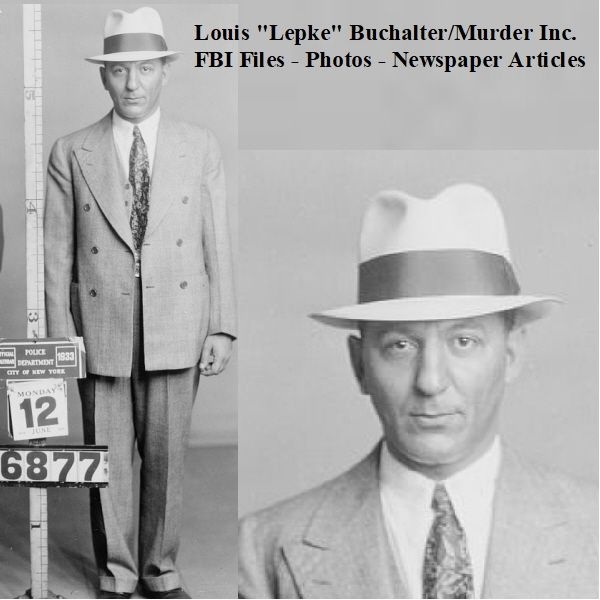
Louis “Lepke” Buchalter/Murder Inc. FBI Files – Photos – Newspaper Articles
$19.50
Description
Lepke Buchalter: Rise and Fall of a Mob Boss
1897
- February 6: Louis Bookhouse (later known as Louis Buchalter or Louis “Lepke” Buchalter) is born in New York City.
Early 1900s (Specific year not provided, but before 1915)
- Louis Buchalter becomes a member of the Amboy Dukes street gang in Brownsville, Brooklyn.
1915
- September 2: Louis Buchalter is first arrested on a burglary charge.
1930s (Specific year not provided)
- Louis Buchalter and Jacob “Gurrah” Shapiro run protection and union rackets in the garment industry on the Lower East Side of New York.
- Lucky Luciano co-founds the National Crime Syndicate, or “Commission.”
- Murder, Incorporated, a Syndicate enforcement arm, is formed and operates out of Midnight Rose’s candy store in Brownsville, Brooklyn.
- Lucky Luciano puts Louis Buchalter in control of Murder, Inc., as a reward for his assistance in the Castellammarese War. Albert Anastasia is also a prominent member.
1935
- Dutch Schultz is facing a tax evasion prosecution led by federal attorney Thomas E. Dewey.
- Schultz seeks a hit on Dewey from the Commission, which initially plans it but then cancels due to fear of repercussions.
- Schultz declares he will kill Dewey himself.
- Buchalter tells the Commission that Schultz must be killed to protect the Syndicate.
- Buchalter assigns Mendy Weiss and Charlie “The Bug” Workman to kill Schultz.
- Weiss and Workman shoot Schultz and his crew at the Palace Chop House and Tavern in Newark, New Jersey. Schultz dies two days later without revealing his assailants.
- After Schultz’s death, Lepke Buchalter takes over many of his rackets.
1937
- Louis Buchalter senses his connections won’t protect him from prison and goes underground, ordering the killing of witnesses and potential witnesses.
1939
- It is believed Louis Buchalter arranged for Murder Inc. hit men to kill at least 12 low-level mobsters who might testify against him, leading some fearful mobsters to cooperate with the law.
- Abe Reles is arrested for the murder of Red Alpert.
- Reles realizes Brooklyn Assistant District Attorney Burton Turkus is building a strong case against him.
- Reles cooperates with authorities for immunity, providing detailed information about 85 murders committed by Murder Incorporated.
- Reles’s testimony leads to the conviction and execution of Harry “Pittsburgh Phil” Strauss, Martin “Bugsy” Goldstein, Mendy Weiss, and Harry “Happy” Malone in Sing Sing’s electric chair.
- Reles implicates Buchalter in the 1936 murder of Joseph Rosen (a former garment district truck driver Buchalter feared was talking to the police) and three other murders.
1940
- March: Louis Buchalter is sentenced to 15 years to life in federal court on racketeering charges.
- April: Louis Buchalter is sent to Leavenworth Penitentiary.
1941
- Louis Buchalter is sent back to New York from federal custody to face trial for the murder of Joe Rosen.
- November 12: Abe Reles, under police protection, mysteriously falls to his death from a window of the Half Moon Hotel in Coney Island. Albert Anastasia is believed to have put out a $100,000 contract on Reles.
- December: Louis Buchalter is convicted of Joe Rosen’s murder.
1942
- Louis Buchalter loses his last appeal for the Joe Rosen murder conviction. He fights being turned back over to New York authorities from federal custody.
1943
- July 20: Louis “Lepke” Buchalter arrives at the Court of Appeals in Albany, New York, for a hearing (photograph taken).
- Approximate: Moey Dimples, who set up Buchalter’s surrender, is killed in a shootout in a New York restaurant.
- Louis Buchalter, still a fugitive from state authorities, is tricked into surrendering to FBI Director J. Edgar Hoover, believing he had a deal for a federal trial only. Walter Winchell is present. Buchalter learns there is no deal.
1944
- January: Louis Buchalter is sent to Sing Sing prison in New York.
- March 2: Buchalter is scheduled for execution at 11:00 PM along with Louis Capone and Mendy Weiss. Thomas E. Dewey, now Governor of New York, orders a 48-hour stay for court review, possibly due to Buchalter’s claims of having information on corrupt officials. Joseph Palmer and Vincent Sallami are executed that night.
- March 4: After his final appeals are rejected, Buchalter has his wife read a message denying he offered to talk for commutation.
- March 4, 11:00 PM: Louis Capone is executed, declared dead at 11:05 PM.
- March 4, Approximately 11:05 PM: Mendy Weiss is executed, declared dead at 11:10 PM.
- March 4, 11:16 PM: Louis “Lepke” Buchalter dies in the electric chair at Sing Sing Prison. He is the first and only mob boss to be legally executed.
Cast of Characters
- Louis “Lepke” Buchalter (aka Louis Bookhouse, Little Louis): Born February 6, 1897. A notorious mob boss and leader of Murder, Inc. He started with the Amboy Dukes street gang, rose through the ranks, and became known for his violence in collecting protection money. He ran protection and union rackets in the garment industry with Jacob “Gurrah” Shapiro. He was placed in control of Murder, Inc. by Lucky Luciano. He ordered the murder of Dutch Schultz and Joseph Rosen. He was eventually convicted of racketeering and murder, and was the first and only mob boss to be legally executed.
- Abe Reles (aka “Kid Twist”): A hit man for Murder, Incorporated. Arrested in 1939 for the murder of Red Alpert. He cooperated with law enforcement (specifically Brooklyn Assistant District Attorney Burton Turkus) to avoid the electric chair, providing detailed testimony about 85 murders committed by Murder Inc., which led to the convictions and executions of several mobsters, including Mendy Weiss. He died mysteriously by falling from a hotel window while under police protection in 1941.
- Jacob “Gurrah” Shapiro: An associate of Louis Buchalter, with whom he ran protection and union rackets in the New York garment industry.
- Lucky Luciano: A prominent mob boss who co-founded the National Crime Syndicate (the “Commission”). He put Louis Buchalter in control of Murder, Inc. after the Castellammarese War.
- Albert Anastasia: A significant member of Murder, Inc. It is believed he put out a $100,000 contract on Abe Reles after Reles cooperated with authorities.
- Dutch Schultz: A gangster facing a tax evasion prosecution led by Thomas E. Dewey. He wanted Dewey killed, and when the Syndicate refused, he vowed to do it himself, leading to his assassination by Murder, Inc.
- Thomas E. Dewey: Federal attorney who led the tax evasion prosecution against Dutch Schultz. He later became Governor of New York and, moments before Buchalter’s scheduled execution, ordered a 48-hour stay. He was a potential presidential candidate.
- Mendy Weiss: A hit man for Murder, Inc., one of the “best” according to Buchalter, who was assigned to kill Dutch Schultz. He was later convicted based on Abe Reles’s testimony and executed in the electric chair alongside Louis Buchalter and Louis Capone.
- Charlie “The Bug” Workman: A hit man for Murder, Inc., assigned by Buchalter to kill Dutch Schultz, alongside Mendy Weiss.
- Martin T. Manton: A U.S. Circuit Court Judge who overruled a decision to deny Buchalter appeal bond, allowing his release on bail. He was later removed from the bench for “shady dealings.”
- Red Alpert: An individual whose murder led to the arrest of Abe Reles in 1939.
- Burton Turkus: Brooklyn Assistant District Attorney who built a case against Abe Reles, compelling Reles to cooperate and provide testimony against Murder, Inc.
- Harry “Pittsburgh Phil” Strauss: A Murder, Inc. member who was put to death in Sing Sing’s electric chair based on Abe Reles’s testimony.
- Martin “Bugsy” Goldstein: A Murder, Inc. member who was put to death in Sing Sing’s electric chair based on Abe Reles’s testimony.
- Harry “Happy” Malone: A Murder, Inc. member who was put to death in Sing Sing’s electric chair based on Abe Reles’s testimony.
- Joseph Rosen: A Brooklyn candy store owner and former garment district truck driver. Buchalter feared he was talking to the police, and Rosen’s 1936 murder (implicated by Abe Reles) led to Buchalter’s conviction and execution in New York.
- Moey Dimples: An acquaintance of Louis Buchalter since childhood who told Buchalter a false deal had been made with the Feds for his surrender, leading to Buchalter being tricked into turning himself in to J. Edgar Hoover. Moey Dimples was killed in 1943.
- J. Edgar Hoover: Director of the FBI. Louis Buchalter was tricked into surrendering to him, believing a deal was in place. Hoover informed Buchalter there was no deal.
- Walter Winchell: A columnist and broadcaster who was present in the car when Louis Buchalter surrendered to J. Edgar Hoover.
- Louis Capone: An associate of Louis Buchalter, convicted and executed in the electric chair at Sing Sing on March 4, 1944, just before Buchalter.
- Joseph Palmer: A prisoner scheduled for execution on March 2, 1944, along with Buchalter, Capone, and Weiss. He was convicted of the murder of Brooklyn police detective Joseph Miccio and was executed that night when Buchalter’s execution was stayed.
- Vincent Sallami: A prisoner scheduled for execution on March 2, 1944, along with Buchalter, Capone, and Weiss. He was convicted of the murder of Brooklyn police detective Joseph Miccio and was executed that night when Buchalter’s execution was stayed.
- Joseph Miccio: A Brooklyn police detective whose murder led to the conviction of Joseph Palmer and Vincent Sallami.
- Joseph Nowak: An Albany detective photographed holding a machine gun while Louis “Lepke” Buchalter arrived at the Court of Appeals in Albany on July 20, 1943.
- President Roosevelt: The U.S. President during the time of Buchalter’s final appeals. Newspaper speculation suggested Buchalter might have information implicating someone in his administration.
532 pages of FBI files, photos and newspaper articles related to Louis “Lepke” Buchalter.
Material includes:
Louis “Lepke” Buchalter FBI Files
203 pages of files dating from 1935 to 1966. Material includes summaries of Buchalter’s background, criminal history, relatives, and associates. Information about labor racketeering and extortion in the 1930’s New York City garment industry. Files include examples of newspaper accounts during the period.
Abe Reles FBI Files
197 pages of FBI files concerning Abe Reles, also known as “Kid Twist.” Files date from 1940 to 1970 and contain approximately 55 pages of discernable memos. Contains information on the FURDRESS investigation into racketeering in the New York garment industry, the Bureau’s recommendation that Reles receive immunity in exchange for testimony and the number of cases he could be called on to give testimony.
Newspaper Articles
102 full sheet pages of newspapers with articles including coverage of Louis Buchalter dating from 1939 to 1945. Mostly from the Washington Evening Star and Wilmington North Carolina Star.
News Service Photos
Fifteen photos taken by news service photographers of Lepke Buchalter. Photos of Louis Buchalter in police custody from 1933 to 1943. Includes: A photo of Lepke handcuffed to FBI Director J. Edgar Hoover, after being tricked into surrendering. A photo taken in court while being sentenced to death.
About Louis “Lepke” Buchalter and Murder Inc
Louis Bookhouse, also known as Louis Buchalter or Louis “Lepke” Buchalter was born on February 6, 1897, in New York City. Lepke means “Little Louis” in Yiddish. He became a member of the street gang, Amboy Dukes, based in the Brownsville section of Brooklyn. Buchalter was first arrested September 2, 1915, on a burglary charge. Buchalter along with Jacob “Gurrah” Shapiro ran protection and union rackets in the garment industry on the lower east side of New York. Buchalter was known to be more violent than others in the collection of protection money, quicker to kill someone for not paying up. His criminal success caught the attention of top mob bosses.
Lucky Luciano co-founded a crime cooperative that became known as the National Crime Syndicate, or the “Commission,” made up of major crime bosses from across the country and the Five Families of New York. The Syndicate divided and regulated the illicit markets around the nation. Each gang in the Syndicate had its own franchise, such as gambling, drugs, or prostitution. One section of the Syndicate enforced the Syndicate’s business and performed murders for hire and was known as “Murder, Incorporated.” For decades, the FBI denied the existence of such an organization as the “Syndicate.” When Bugsy Siegel and Meyer Lansky moved on to the west coast, Luciano put Buchalter in control of Murder, Inc. Luciano gave this authority to Buchalter as a reward for his assistance during the Castellammarese War, in which mob bosses Giuseppe “Joe the Boss” Masseria and Salvatore Maranzano were murdered and Luciano rose to the top of the underworld. Murder, Incorporated also featured the talents of Albert Anastasia. Murder Incorporated operated out of a candy store called Midnight Rose’s, in the Brownsville section of Brooklyn. Crime researchers believe that Murder Inc. was responsible for between 400 and 800 murders.
In 1935, Dutch Schultz was facing a tax evasion prosecution. The investigation was led by federal attorney Thomas E. Dewey, who was brought in as a special prosecutor. Schultz wanted Dewey dead and went to the Commission to encourage a hit on Dewey. The Syndicate’s Murder Inc. at first planned the hit, however the Syndicate canceled the plans, fearful of the repercussions of killing Dewey. An outraged Schultz declared that he would do it himself. Buchalter told the Commission that to protect the Syndicate, Schultz should be killed before he could have a chance to kill Dewey. Buchalter put two of Murder Inc.’s. best hit men on the job, Mendy Weiss and Charlie “The Bug” Workman. They shot Schultz and members of his crew at the Palace Chop House and Tavern, in Newark, New Jersey. In the two days it took Schultz to die from the gunshots he received in the bathroom of the Newark steakhouse, he refused to reveal who had shot him. After Schultz’s death, Lepke Buchalter took over many of Schultz’s rackets.
Louis Buchalter was convicted on federal racketeering charges. Buchalter was denied an appeal bond, however, U.S. Circuit Court Judge Martin T. Manton overruled the decision, and Buchalter was released on $3000 bail. Judge Manton would later be removed from the bench, because of his shady dealings. In 1937, Lepke Buchalter sensed that his connections were not going to save him from going to prison. Buchalter went underground and sought to have witnesses and potential witnesses killed. It is believed that in 1939, Lepke Buchalter arranged for Murder Inc. hit men to kill at least 12 low-level mobsters, who might testify against him. This caused some fearful low-level mobsters to cooperate with the law.
Murder Inc. hit man Abe Reles was arrested in 1939 for the murder of Red Alpert. Reles realized that Brooklyn Assistant District Attorney Burton Turkus was putting together a case against him, through the use of cooperating witnesses, which would stick. Reles cooperated with the legal authorities to receive immunity instead of the electric chair. For two weeks Reles, also known as “Kid Twist”, gave detailed information about 85 murders committed by Murder Incorporated. Abe Reles’s testimony led to Harry “Pittsburgh Phil” Strauss, Martin “Bugsy” Goldstein, Mendy Weiss, and Harry “Happy” Malone being put to death in Sing Sing’s electric chair. Abe Reles gave information about the 1936 murder of a Brooklyn candy store owner named Joseph Rosen. Rosen was a former garment district truck driver who Buchalter feared was talking to the police. Reles gave information that implicated Buchalter in three other murders. It is believed that Albert Anastasia put out a $100,000 contract on Reles. On November 12, 1941, while in the protection of six police officers, Reles mysteriously fell to his death from a window of the Half Moon Hotel in Coney Island.
A $50,000 reward was put out for the fugitive Lepke. A worldwide search was in effect to find Buchalter. Buchalter had never left Brooklyn. Louis Buchalter feared that the search for him might make him a liability to the Syndicate. Someone he knew since childhood, Moey Dimples, went to Lepke and told him that a deal was made with the Feds. Buchalter was told that if he surrendered himself to J. Edgar Hoover, the feds would try him, but not turn him over to New York authorities. Buchalter figured he was facing a maximum 15 years federal sentence. Buchalter was driven from his safe house on Coney Island into Manhattan. Lepke went into a waiting car at the corner 0f 28th Street and Fifth Ave, with columnist and broadcaster Walter Winchell in back. They were later joined by FBI Director J. Edgar Hoover. Hoover told Buchalter that he had been set-up and that there was no deal. Moey Dimples would be killed in a 1943 shot-out in a New York restaurant.
In March of 1940, Louis Buchalter was sentenced to a term of 15 years to life in federal court. Lepke was sent to Leavenworth Penitentiary in April 1940. Louis Buchalter brought legal challenges to prevent him to being sent back to New York. In 1941, he was sent back to New York to face trial for the murder of Joe Rosen. Buchalter was convicted that December. In 1942, Buchalter lost his last appeal. At the time he was in federal custody. He fought being turned back over to New York authorities, trying to call in favors from those in the justice system with whom he had prior dealings. In January 1944, Buchalter was sent to New York’s Sing Sing prison.
Buchalter was scheduled to be executed on March 2, 1944 at 11:00 PM, along with his associates Louis Capone and Mendy Weiss. Moments before the executions, Thomas E. Dewey, now governor of New York, ordered a 48 hour stay for more time for court review of the case. Two other prisoners who were scheduled to die that night, Joseph Palmer and Vincent Sallami, convicted of the murder of Brooklyn police detective Joseph Miccio, had their electrocutions performed that night. Louis Buchalter had let it be known that he had information that could bring down New York City elected officials, national labor leaders, and public office holders. There was speculation in the newspapers that Buchalter could finger someone in the President Roosevelt administration. This could help Dewey in his anticipated presidential campaign. Dewy decided not to engage with Buchalter.
After the last appeals were rejected on March 4, Buchalter had his wife read a message from him. It stated that he did not offer to talk and give information in exchange for any promise of commutation of his death sentence. On March 4 at 11:00 PM, Louis Capone was taken to the death chamber, Capone was declared dead at 11:05 PM. Mendy Weiss was strapped to the chair next and died in three minutes. Weiss was declared dead at 11:10 PM. Louis Lepke Buchalter died in the electric chair at Sing Sing Prison on March 4, 1944 at 11:16 PM. Buchalter was the first and only mob boss ever to be legally executed.
Related products
-
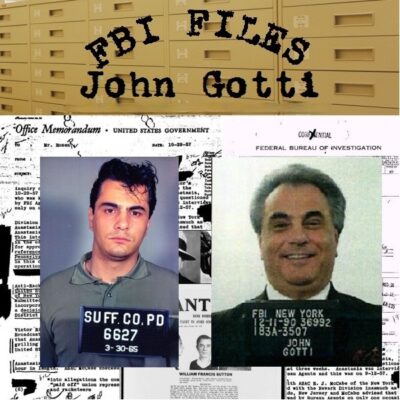
John Gotti FBI Files
$19.50 Add to Cart -
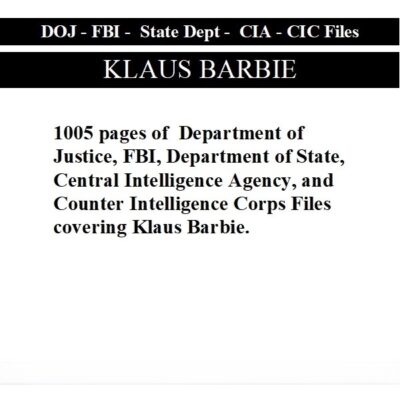
Klaus Barbie: Department of Justice – FBI – Counter Intelligence Corps Files
$19.50 Add to Cart -
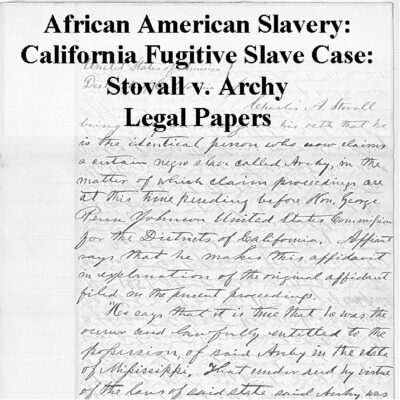
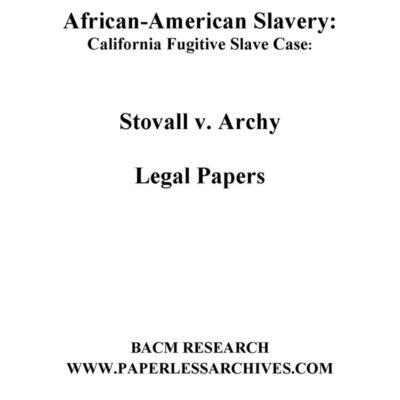
Legal Papers from the California Fugitive Slave Case: Stovall v. Archy
$4.99 Add to Cart -
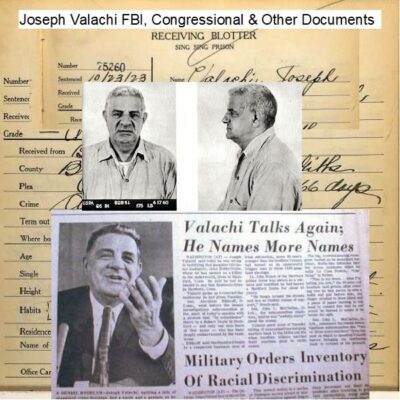
Joseph Valachi FBI Files – Congressional Hearings & Other Historical Material
$19.50 Add to Cart